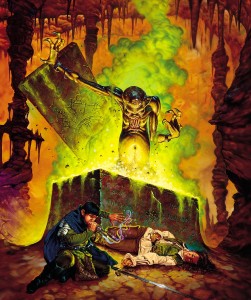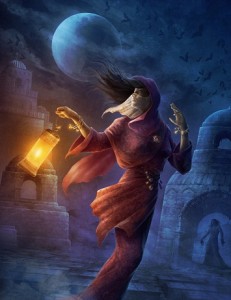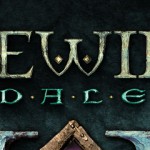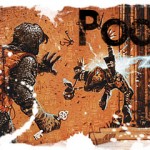
I’ve been running a lot of horror in my game lately, mainly due to the fact that my current homebrew campaign is a 4th edition rendition of 2e Ravenloft with a touch of my personal flavor.
Sure almost every homebrew I’ve ever created has had a lot of horror elements in it, whether it was rife with undead or a vampire posing as the main antagonist, but never before have I created (or in this case used) a world where everything is dark.
We are six sessions in right now and while my players and myself are definitely highly enjoying it, I cant help myself from picking my own work apart already. One thing I’m always trying to do is analyze my own GM’ing habits to then self prescribe a way to improve them. So I thought I should share with you some of my follies and triumphs in running the campaign so far – bear in mind this is definitely an art form I’m very new to but I’ll try and share my shiniest pearls of wisdom.
All Show is No Show
While when you think about a horror campaign you often think of writhing zombies, skeletons, vampire bats, werewolves and all that sort of thing, but what you don’t often ponder is “how often should these things will be showing up?” The photo montage of awesomeness in your mind shouldn’t be an instant replay of every game session.
These are climactic moments in your game, and if every time your players turn around they are faced with something extremely gorey, depraved or outright horrifying they’ll soon grow numb to your ‘shock effect’. One thing I learned in desktop publishing that I believe applies to all facets of life is the phrase “all show is no show”.
“The oldest and strongest emotion of mankind is fear, and the oldest and strongest kind of fear is fear of the unknown” ~ H.P. Lovecraft
While this itself isn’t something I’ve stumbled over yet, it’s been a hard task not to. It’s really easy to start dreaming up your campaign and want to completely litter it with creepy children with glowing eyes, festering corpses, vampires who walk on the ceiling and headless horsemen for no good reason other than the cool-factor. Doing all of this within a short timespan would be unwise, tension is a key element in horror. The tense music as someone creeks open a door, the completely ordinary scene that festers with unseen evil or the twisted portrayal of innocence (children of the corn, creepy dolls, etc.) are things that drive the most gripping moments of terror and intrigue.
Never Explain Anything
Never let your players know everything, it’s not to say to keep them entirely in the dark 100% of the time, but when they *think* they have figured something out – it should be just that, a thought and nothing more. Perhaps they’re only half right, but the minute you let them onto knowing exactly why and how everything works is the moment they stop letting their guard down.
“There are some secrets which do not permit themselves to be told.” ~ Edgar Allen Poe
I’ve thrown a lot of things into this campaign so far, and the players really dont know what the hell it all adds up to. To be perfectly honest, neither do I! That’s the joy of it all though, not only does it leave your GM’ing leeway but because as long as your players aren’t certain of things you can always keep them on their toes. Always make them second guess what is bumping around in the dark or what exactly is motivating your key NPC’s and Villains. I know that’s kind of basic advice but it’s particularly pertinent to campaigns with dark and enigmatic themes.
Sunk Into Velvet
Atmosphere in a dark world where evil lurks around every corner should be thick and ever-present, even if only done so subtly. Try and do your best to ensure that the world itself feels living and breathing, rife with detail in the fluff and the crunch. A lot of the campaign settings change character classes, spells, races and more to really set the scene. So far I’ve failed to do this but I’m working to retroactively apply some changes to my groups class features and overall feel. Give good thought to reflavoring powers, feats, etc before jumping into a new horror based campaign if you can. I’m sure throwing class changes at your players midstream is probably not the best way to handle things, but since hindsigh is 20/20 – I’m doing it anyway.

You really want everything about your horror game to feel unique, not like someone tossed Merlin, Conan and their buddies into a haunted castle attraction. Go all out to set the mood for your games as well, haunting music is a must as well as proper lighting. If your players complain that they can’t see their character sheets – tell them to deal with it and use the backlight on their cell phone if need be.
It’s all part of the immersion, it really helps pull them into the story you’re enveloping around them. If you’re not too shy, try and emphasize voice as well even if it doesn’t mean making one for every NPC – drop your narrative voice to a lower more sombre tone than your players are accustomed to. It may seem silly at first, but it works.
Strands of Fate
Choices made in a horror campaign should be especially akin to games like Fable, or Dragon Age where that every single thing you do has reprecussions and they often aren’t without grave consequences. That being said, character alignment and development choices also weigh heavily in games like this, let’s take Ravenloft as an example.
Ravenloft is a demi-plane that isn’t really part of the “world” and it is an entity in itself, bound by ever shifting mists. The lands themselves feeds on and embrace evil so when a character might use shadow or spell of otherwise “necromantic” nature they are being fed into the maw of evil that surrounds them, if only one small sip at a time. Those who are good are scarce and must operate in secret, neutral is the defacto standard for most common folk and the many flavors of evil will color in 99% of their adversaries.
Those who meddle in evil affairs will be tempted with dark gifts, it will seep under their skin and hold onto their hearts. Those who stand above and beyond this evil will be sought out and hunted, and in between he have a thick band of gray morality – which is an element I truly believe that makes horror campaigns so great. Having a mixed bag of alignments in your party will also make for some very interesting dynamics with plenty of room for plot exploration and added tension.
Inside The Hearts of Men
 Humans are predominant in most horror campaigns, not to say that other races don’t exist but they tend to fall by the wayside, but there’s a good reason for that perhaps. The focus of horror truly lies within the hearts of men – tempation, power, lust, hubris, arrogance, dominance and love have always been focal points of dark fantasy and horror.
Humans are predominant in most horror campaigns, not to say that other races don’t exist but they tend to fall by the wayside, but there’s a good reason for that perhaps. The focus of horror truly lies within the hearts of men – tempation, power, lust, hubris, arrogance, dominance and love have always been focal points of dark fantasy and horror.
It’s for these same reasons that as much as the PC’s in your game are “human” for lack of better words, their adversaries really should be too. Aside from creatures of the night and other ‘garden variety’ bad guys, the ones that count should feel real. Every vampire had a life before being turned, every werewolf may struggle with feral reactions and every lich had reasons they decided to abandon their bodies.
“Whatever is done for love always occurs beyond good and evil.” ~Friedrich Nietzsche
Even the most imposing, evil and depraved enemies have a weakness or two. I’m not talking about silver bullets and wooden stakes either, I’m talking about a lost love or a yearning to avenge someone or something. Play into these things and allow your players to discover them as well and you may find that, as true to real life not always being so cut and dry that even your PC’s may find themselves stumbling through the gray mists of morality when it comes to whether or not they should pursue and slay your antagonists or just have pity on them.
Back Into the Darkness
And so that’s about all the pearls of wisdom I have for you on this topic right now. This weekend starts Session 6 and what I’m calling “Chapter 2” of my game – wherein the players learn a lot more about Ravenloft and perhaps find a few lingering clues on how to escape it, they may point towards this crazy ‘Acererak’ guy or perhaps even a ‘City of Doors’.
I’m leaving these possibilities in, in case I totally fuck up this horror thing I’ve got going or just in case I get bored. That being said, what do you guys think? Did you gain anything useful from this, and do you have anything you might be able to throw my way as far as tips go when running a horror game? I’d appreciate any and all of them. Thanks for reading!



Awesome article. I’m about to embark on a journey much the same as yours. I’m kicking off a new 4e campaign in a few weeks and, as a 2e Ravenloft DM, I can definitely empathize with you. Do you have an pointers, or things you wish you had done from the beginning? Also, did you let your players in on the fact that you were taking them to/starting in Ravenloft or did they have to figure that out?
I’d love to see some of the crunch you’ve modded for 4e as well.
The “all show is no show” advice made me think about my campaign, where there’s an emphasis on fae and elementals. I’m eager to show those things off in adventures and now I realize that doing so might ruin the specialness of these things.
I was fortunate that I didn’t have to actively reflavor any powers or character classes (apart from disallowing certain ones); my players got the general idea and totally bought in on designing their characters around it without my guidance.
Speaking of, limiting classes and races can help flavor any game, I think. Maybe your horror game doesn’t need a barbarian tromping around through it. Or maybe a wilden wouldn’t quite fit in the villages of Barovia.
As for “never explain anything”, some of the many twists I’ve thrown at my players came from them! I always try to leave myself open and am not above stealing their ideas whole-cloth, whether I make them true or false in the end. They think that NPC is behind the strange goings-on? Well, he is now! They think an amulet is causing problems? Maybe it is… but maybe it’s not! Let’s let them think so for a while! 😀
I also have a problem with revealing to much to often in my game because I always think “O this is an awesome idea they will love this.” So I want to show off and since we play only twice a month, holding back information sometimes means for 6 to 7 months before the right ‘moment’ hits to reveal something; but this is my problem not my players and something I need to overcome.
I would also say the limiting of player choices (such as mostly human players) would help feed into the setting more. I doubt you want a Deva Paladin running around in a Horror game but I digress.
4e has gotten rid of a lot of the alignment stuff from 3.X such as Detect Evil and Circles of Protection; I would consider bringing those back for a horror game.
I have also noticed that Rituals at times are an after thought to the hardcore grid system 4e seems to use most of the time and I think this is a mistake. Some of the most evil things I can think of involve long drawn out rituals with material components ranging from eye of newt to the blood of a innocent (Lawful good) female; which would be a rarity to find in Ravenloft.
On choices I think the true horror is choosing which is the ‘lesser’ evil. In horror often times there is no right choice; so give them to bad choices and see where they take the story.
Also I have found that a unhurtable enemy is sometimes the scariest. My brother was always been scared of ghost because you can not touch them to hurt them, they can do whatever they want, whenever they want. Now this may not be true in DnD but there are other things that could frighten the party in a similar way; a plague of unknown origins, a evil statue causing citizens to go mad or perhaps a ghost who te party can not hurt unless they find a sanctified weapon. These examples can of course lead to single enemies and a swinging of blades but they could also just be mysteries.
I would also say make the game personal. Find out what scares your players and what may scare their PCs. Use this to your advantage. I DMd a group where several players hated spiders and guess what they ran into; an ancient crypt filled with Gargantuan spiders.
Sometimes to help set the mood great music can be played in the background or you can even show clips of movies (In the spider game I played a montage of Arachnophobia, Resident Evil 2 -spiders in the sewers- and a old outer limits episode)
Lastly resource management I think is another thing to strike fear into the party. Maybe when they rest they only gain back 1 healing surge; things of this nature where the real sense of dread from every hit comes into play.
Anywho great article those are just my random thoughts
Pingback: Weekly Roundup – The Weekly Roundup is Moving! Edition | Roving Band of Misfits